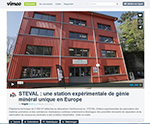Treatment of Resources and Residues
Energy and mineral resources are critical elements in the development of industrialised economies. A recent spike in the demand for raw materials and metals (close to 350 % for copper and zinc in the 3 years prior to the global economic crisis, followed by a renewed increase, especially in gold) has inspired increased efforts to search for new deposits and develop new minerallurgical techniques.
Under worldwide pressure, the mineral industry, regardless of the resource, now faces a number of major technological challenges, including:
- The exploitation of low-grade resources. For example, ppm concentrations of uranium (U) present in complexly-zoned carbonates are now being exploited.
- For some metals, a recourse to unconventional resources. This might include, for example, U in pyrochlore, the exploitation of refractory minerals, the exploitation and treatment of underwater resources, or the exploitation of secondary resources such as mining residues and the processing of metals that are indispensable in the development of state-of-the-art technologies (In, Ge, Te, etc...).
These strong trends are engendering new technological and scientific challenges that demand a solid understanding of both the fundamental properties of these materials and the methods required to exploit them. In low-grade ores, but also in more-common sources (e.g., clays/feldspars, quartz/feldspars), valuable substances often exhibit a low property contrast with their associated gangue (or waste) minerals. The quality of their separation therefore depends on obtaining a detailed knowledge of the property contrasts and on the development of highly selective separation techniques.
The objectives of mineral engineering are to increase our knowledge and use of mineral resources and the methods used for processing the residues of human activity. The fundamental concepts involved include determinative mineralogy, energy-field physics, surface physico-chemistry and solid-state physics. Achieving this requires a geological and mineralogical inventory and diagnostics to be established through close collaboration with the “Mineral Resources” team, and the development of innovative separation methods using fields and mineral residue inerting.
See the video :

